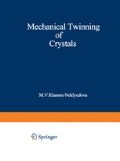Abstract
Garber’s experiments showed that the length of a mechanical twin as a function of load shows very little hysteresis and very little relation to the loading rate or to the temperature, which gave one reason to hope that twinning can be treated as a static problem corresponding to minimum potential energy. However, the problem cannot be solved generally within the framework of the macroscopic theory of elasticity; further simplifications are needed.
Access this chapter
Tax calculation will be finalised at checkout
Purchases are for personal use only
Preview
Unable to display preview. Download preview PDF.
Rights and permissions
Copyright information
© 1964 Consultants Bureau Enterprises, Inc
About this chapter
Cite this chapter
Klassen-Neklyudova, M.V. (1964). Macroscopic Theory of Twinning. In: Mechanical Twinning of Crystals. Springer, Boston, MA. https://doi.org/10.1007/978-1-4684-1539-1_8
Download citation
DOI: https://doi.org/10.1007/978-1-4684-1539-1_8
Publisher Name: Springer, Boston, MA
Print ISBN: 978-1-4684-1541-4
Online ISBN: 978-1-4684-1539-1
eBook Packages: Springer Book Archive

